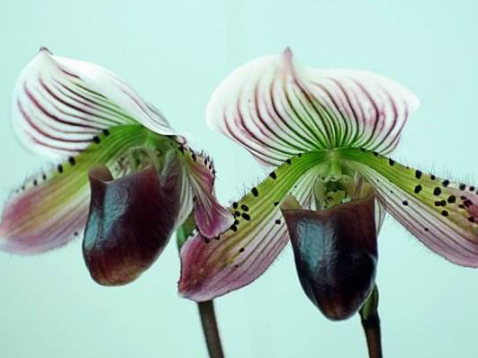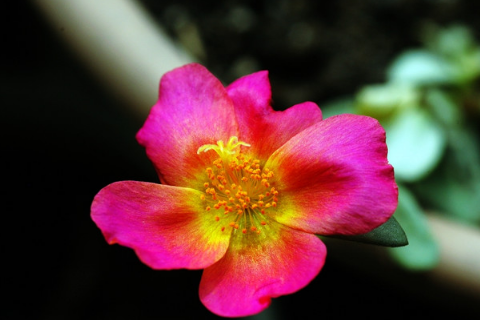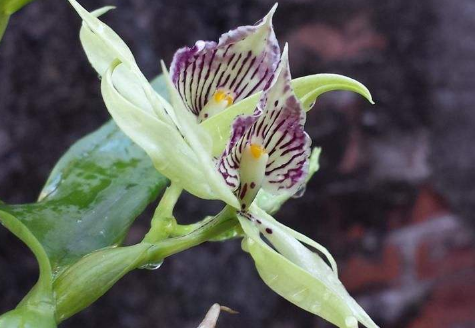Culture methods of Paphiopedilum
1. soil
Paphiopedilum potted plants can be configured with moldy soil, peat, etc. When the basin can be on the first mat on a layer of broken brick particles to maintain good ventilation, conducive to the growth of plant roots.
2. temperature
Paphiopedilum like warm environment, different varieties of suitable temperature is also different, green leaf varieties suitable temperature is 12-18℃, spotted leaves suitable for growth in 15-25℃ environment, winter suitable temperature in 10-15℃, summer temperature can not be higher than 30℃. Winter temperatures below 10℃ in time to go indoors.

3. illumination
Paphiopedilum shade, growth process needs the right amount of light, spring is best in a semi-shady environment; summer hot, need a lot of shade, can see the light in the morning and evening; winter must be more sun.
4. moisture
Paphiopedilum like wet environment, not dry, to keep the pot soil moist, slightly dry can be watered, summer but also to plant around watering, to increase air humidity. Pay attention to ventilation and proper water control during the rainy season.
Method for cultivating paphiopedilum
Paphiopedilum is an evergreen herb. Native to tropical Asia to the Solomon Islands. There are about 10 species in China, mainly distributed in Yunnan, Guangxi and Guizhou, and about 50 species in nature.
Morphological characteristics without false bulbs, stems from the ground out of rhizomes. Leaves banded, leathery, surface grooved, dark green or patchy. Flowers terminal, often single flowers, a few species have several flowers. Lateral sepals united, often concealed behind labellum, middle sepal large and erect above; lateral petals often narrow and long, or twisted, labellum large pocket-shaped, stamen stout, with 2 lateral stamens and a large staminodes.
The original species of Paphiopedilum are also beautiful and easy to cultivate, and most of the common ones are original species. The main famous native species are described below:
Beautiful Paphiopedilum: Originating in India, all parts of China have potted plants, but also excellent cut flower cultivation species.
The Philippines: The Philippines. Each inflorescence has several flowers, like high temperature, often can cultivate into clusters, flowers more than 10.
With leaf orchid: Guangxi, Yunnan and Guizhou, China, India also has distribution. Terrestrial or lithophytic, leaves up to 40 cm. Flowers solitary.
Sumatra Orchid: ^5. 1667 cm ^^>^711^variant. Its biggest advantage is that one flower has many flowers and annual flowers continuously, and one pot of large clusters can bloom annually. The flowers are pure green and the lips are nearly white.
Paphiopedilum armeniacum: a newly discovered new species, native to Bijiang, Yunnan. Adhering to rock wall in place of origin, leaves with bony protuberances and purple dense spots, flowers apricot yellow.
Hong Kong Paphiopedilum: Native to South China. Flowering June to September. It should be cultivated in medium temperature greenhouse.
White flowers: white flowers, flowering 4 ~ 8 months. Suitable for high temperature greenhouse cultivation.
The ecological habits of Paphiopedilum, the original species are mostly born in the humus-rich soil under the temperate climate forest, or under the bushes, or in the moss on the rocks, occasionally attached. Like overcast and humid environment, avoid ponding. No dormancy.
Propagation methods are commonly used for the propagation of Paphiopedilum. Generally, it is advisable to divide the plants when the mother plants grow to sufficient size, and divide the plants once every 2 to 3 years for those who grow vigorously. new plant response at meristem
Three seedlings are appropriate. Often in the spring just see new seedlings when combined with pot change.
Cultivation and maintenance of Paphiopedilum root system is not developed, and there is no aerial root and pseudobulb, so its cultivation substrate needs better water retention, generally add 50% peat soil to the bark substrate. Paphiopedilum has no dormancy period, so it needs a small amount of water all year round to keep the substrate sufficiently moist. Too much water or long-standing leaves and buds are easy to bow.| rotting. Summer must shade, avoid strong light. Different species need different temperatures when cultivated, some species originating in India and China, the minimum temperature of about 101 can survive; species originating in the Philippines and other places, the minimum temperature required is 14 ~ 181; modern hybrid cultivation requires higher temperatures. In the growth period should be applied once a month decomposed diluted cake fertilizer water, fertilization, leaves green bright, can continue to fertilize, if the leaves turn yellow, indicating poor root growth, should stop fertilization, otherwise will rot root death.
Horticultural Use When used as interior furnishings in winter, place in a well-lit, ventilated place.
Paphiopedilum flower shape strange, beautiful flower posture, rich and colorful, one of the world's famous flowers, is the world's earliest cultivation and one of the most popular "orchids". Its flowering period can be as long as 4 months. It is an ideal high-grade potted flower for indoor study, living room and bedroom. In recent years, it is often matched with bamboo, asparagus and ferns as an elegant vase flower arrangement to decorate the room.
How does the purple orchids grow?
Paphiopedilum purpureum is an orchid, and Paphiopedilum is a native or semi-epiphyte. Paphiopedilum purpureum is more elegant, color is more solemn, color and with irregular spots or stripes, is an ornamental flowers and plants. The following wed114 marriage network small series bring purple paphiopedilum how to raise, purple paphiopedilum breeding method.
[Recommended reading] How to raise the ribbon The flower language of Paphiopedilum and the cultivation method of legendary Paphiopedilum macropetalum
Introduction to Purple Paphiopedilum
Paphiopedilum purpureum is an orchid, and Paphiopedilum is a native or semi-epiphyte. Leaves basal; several to many, leaves banded, leathery. Scapes grow from leaf clusters, bracts are not leaflike; ovary tips often narrow into beaks; flowers are large and gorgeous, with various colors; calyx erect, pollen powdery or sticky, staminodes flat; stigma thick, curved downward, stigma surface papillae, fruit capsule. It blooms from October to January.
Orchid more elegant, color more solemn, color and with irregular spots or stripes. The petals are thicker and the flowers bloom longer. Paphiopedilum purpureum is an ornamental flower.
I. Morphological characteristics
Paphiopedilum purpureum is a terrestrial or semiepiphyte plant. Leaves basal, biseriate, 3-8; leaf blade narrowly elliptic or oblong-elliptic, 7-18 cm long, 2.3-4.2 cm wide, apex subacute and 2-3 denticulate, upper surface dark green and pale green alternating grid spots, abaxial surface light green, base narrowed into petiolate and folded into each other, margin slightly ciliate.
Paphiopedilum purpureum Scape erect, 12-23 cm long, purple, densely pubescent, 1-flowered at tip; floral bracts ovate-lanceolate, embracing ovary, 1.6-2.4 cm long, ca. 1 cm wide, abaxially pilose, margin long ciliate; pedicels and ovary 3-6 cm long, densely pubescent; flowers 7-8 cm in diam. Middle sepals white with purple or purplish red coarse veins, synsepals pale green with dark veins, petals purplish red or light maroon with dark longitudinal veins, green-white halo and black wart spots, lips purple-brown or light maroon, staminodes slightly lighter in color than lips with yellowish green halo; middle sepals ovate-cordate, 2.5-4 cm long and wide, apex short acuminate, margin incurved and sparsely ciliate, abaxially pubescent; Sepals ovate or ovate-lanceolate, 2-2.8 cm long, 9-13 mm wide, apex acuminate, abaxially pubescent, margin ciliate; petals suboblong, 3.5-5 cm long, 1-1.6 cm wide, apex acuminate, only verrucose above and usually glabrous, margin ciliate; labellum obohelmetate, base with broad stalk 1.5-1.7 cm long; Capsule nearly broad oblong-ovate, slightly narrow toward the end, 2-3 cm long, 2.5-2.8 cm wide, capsule mouth extremely broad, each side has an upright ear, the edge in front of both ears is not folded, the capsule bottom has hairs, the capsule is papillae; staminodes reniform semilunar or obcordate semilunar, about 8 mm long, about 1 cm wide, the apex has obvious concave, concave has 1-3 small teeth, there are very minute papillae above. Flowering occurs from October to January.
II. Ecological habits
Paphiopedilum purpureum is born at an altitude of 700 meters below the forest humus-rich stony land or valley moss gravel overgrown land or rock.
Paphiopedilum purpureum has no tissue for storing nutrients, so it needs to ensure the dormancy period of cool-loving varieties. In winter most paphiopedilum have a relatively dry, well-lit growth environment. When Paphiopedilum is cultivated, the plants with large flowers and many flowers are more thermophilic and suitable for indoor cultivation. Paphiopedilum used as flower arrangement should be large and round, so it is not possible to blindly pursue the number of flowers and ignore their quality.
How to raise purple orchids
1. The cultivation method of Paphiopedilum purpureum
1. Cultivation soil
Paphiopedilum purpureum has higher requirements for culture soil. Most Paphiopedilum origin precipitation is more than a few months a year, the air is relatively dry, so Paphiopedilum requires moist cultivation soil throughout the year. In addition, in order to prevent root hypoxia, the culture soil should be well drained.
2. Watering
Soft water (preferably rainwater) should be applied to irrigate flowers, but no water should be accumulated in the basin, otherwise bacteria will multiply in large quantities, which will easily cause plant decay and death. The water for watering flowers in winter should not be too cold. The leaves should not be accumulated for a long time, otherwise the leaves will rot easily. The higher air humidity required for paphiopedilum growth can be achieved in summer by spraying or spraying.
3. Fertilization
Fertilization should be less and more frequent. Generally, the finished fertilizer sold on the market can be used. If organic fertilizer is used, some varieties of Paphiopedilum will be more prosperous. In addition, larger plant varieties require more fertilizer than those with fewer leaves. Fertilizers are sufficient, new buds are fully developed, plants will flower, otherwise they will wait until the next year to flower. Lime fertilizer should usually be applied to all Paphiopedilum varieties once every six months. The dosage can be one teaspoon of lime carbonate per 10 cm of pot diameter. Lime can also be added to watering flowers so that the fertilizer can be absorbed by the plants for a long time.
4. Transplantation
Change the pots every two years, and it would be better if they could be changed once a year. Large plants bloom more often. Do not tear or rip the roots unless necessary. Do not destroy plant tissue when changing pots, otherwise Pythium will take advantage of the opportunity to enter. Powdered charcoal can be used to prevent pythium.
II. Disease control of Paphiopedilum purpureum
Paphiopedilum purpureum is susceptible to red spiders, especially those with smooth leaves. Therefore, blades should be checked frequently. Other pests rarely harm the paphiopedilum.
Common diseases of Paphiopedilum purpureum also include bacterial and fungal infections. Fresh, circulating air can play a preventive role.
The role of Paphiopedilum purpureum
1, viewing role
Paphiopedilum purpureum, also known as slipper orchid, blooms in summer and autumn or winter, with a maximum flowering period of more than 70 days. Paphiopedilum in Southwest China usually has thicker and stronger leaves, brighter and more conspicuous colors, better drought resistance and water retention mechanism, and has very high utilization value in breeding new varieties of stress resistance.
2. Market value
Potted flower of Paphiopedilum purpureum needs 3 to 5 years to produce. Because of its peculiar flower shape, rich color, lasting flowering period and easy management and protection, it can grow in the range of 12 to 30 degrees Celsius and bloom normally at room temperature of 23 degrees Celsius, so it is popular with family consumers. It has great market demand potential. It is one of the orchid species worthy of development and production, and it is also a new variety for developing small potted plant industry.
- Prev

How to raise the dance of falling flowers
Water the soil once a week in spring and autumn to keep the soil moist. It should be properly shaded in summer, keep the soil moist moderately in winter, and the specific watering times depend on the level of room temperature. Fertilize once a month, choose low nitrogen fertilizer or succulent special fertilizer. Light flowering period to ensure sufficient light, move as little as possible, so as not to break the stem and fall flowers.
- Next

Culture method of octopus orchid
1. Octopus orchid soil requirements are not high, to use loose breathable fertile soil, generally choose fine particles of volcanic rock, bark or fire soil, can also buy special culture soil cultivation. 2. The temperature octopus orchid mostly grows in the forest at an altitude of 2000m, and has strong temperature adaptability.
Related
- Fuxing push coffee new agricultural production and marketing class: lack of small-scale processing plants
- Jujube rice field leisure farm deep ploughing Yilan for five years to create a space for organic food and play
- Nongyu Farm-A trial of organic papaya for brave women with advanced technology
- Four points for attention in the prevention and control of diseases and insect pests of edible fungi
- How to add nutrient solution to Edible Fungi
- Is there any good way to control edible fungus mites?
- Open Inoculation Technology of Edible Fungi
- Is there any clever way to use fertilizer for edible fungus in winter?
- What agents are used to kill the pathogens of edible fungi in the mushroom shed?
- Rapid drying of Edible Fungi

